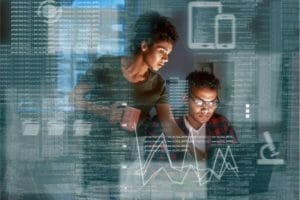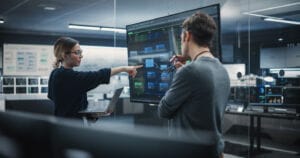In an increasingly digital world, the concept of the “connected worker” has emerged as a key driver of efficiency, safety, and productivity. For government workers, who often operate in complex, fast-paced, and sometimes high-risk environments, connected worker solutions can offer significant advantages. These solutions leverage technology to keep workers informed, safe, and productive, whether they’re in the field, in an office, or managing remote teams.
This article explores the benefits of connected worker solutions for government employees and highlights practical ways to implement these technologies to improve public service.
Understanding Connected Worker Solutions
Connected worker solutions integrate a variety of technologies to create a seamless communication and data-sharing network among employees. These technologies can include wearable devices, mobile apps, cloud-based platforms, and IoT (Internet of Things) sensors. The primary goal is to keep workers informed and connected, enabling them to make better decisions and respond quickly to changing situations.
For government workers, these solutions can be particularly beneficial in areas such as public safety, infrastructure management, and emergency response.
Key Benefits of Connected Worker Solutions for Government Workers
Enhanced Communication and Collaboration
One of the most significant advantages of connected worker solutions is the improvement in communication and collaboration. Government workers often need to coordinate across different departments and locations. Connected worker technologies allow real-time communication, ensuring that everyone has access to the same information. This can be particularly useful during emergencies, where quick and effective communication is crucial.
Improved Safety and Risk Management
Safety is a paramount concern in many government roles, particularly in sectors like public works, transportation, and emergency services. Connected worker solutions can include wearable devices that monitor workers’ health and safety conditions. For example, wearables can track a worker’s location, heart rate, and exposure to hazardous environments, alerting supervisors if there’s a potential safety issue. Additionally, a cutting-edge lone worker safety app can play a crucial role by providing an extra layer of protection for employees working in isolation. These apps enable real-time check-ins, emergency alerts, and GPS tracking, ensuring that help can be dispatched quickly if a lone worker encounters danger or is unable to communicate. This real-time monitoring helps to prevent accidents and ensures rapid response if something goes wrong.
Increased Efficiency and Productivity
With connected worker solutions, government employees can access the information and tools they need instantly. Mobile apps and cloud platforms allow workers to access data, submit reports, and receive updates without having to return to an office. This can significantly reduce downtime and improve productivity, especially for field workers who are constantly on the move. Additionally, these solutions can streamline administrative tasks, allowing workers to focus on their primary responsibilities.
Data-Driven Decision Making
Government agencies are often required to make decisions based on data and evidence. Connected worker solutions can collect and analyze vast amounts of data in real-time, providing government workers and decision-makers with the insights they need to make informed choices. Whether it’s monitoring the progress of a public works project or assessing the impact of a policy, connected technologies can provide the data needed to make accurate and timely decisions.
Better Resource Management
Efficient use of resources is critical for government agencies operating under tight budgets. Connected worker solutions can help by providing real-time data on resource usage, asset locations, and workforce deployment. For instance, in public works, sensors and IoT devices can monitor the condition of infrastructure, allowing for predictive maintenance and reducing costly repairs. This level of insight ensures that resources are used where they are most needed, improving overall efficiency.
Implementing Connected Worker Solutions in Government Agencies
Implementing connected worker solutions in government agencies requires careful planning and consideration. Here are some steps to ensure a successful implementation:
Assess Needs and Objectives
Begin by identifying the specific needs of your agency and the objectives you want to achieve with connected worker solutions. Are you looking to improve safety, increase efficiency, or enhance communication? Understanding your goals will help you choose the right technologies and strategies.
Choose the Right Technologies
The next step is to select the technologies that best fit your agency’s needs. This could include wearable devices, mobile apps, cloud platforms, or IoT sensors. It’s important to choose solutions that are scalable and adaptable, allowing you to expand and adjust as your needs change.
Ensure Training and Support
For connected worker solutions to be effective, government workers need to be properly trained on how to use them. Provide comprehensive training programs and ongoing support to ensure that all employees are comfortable with the new technologies and can use them effectively.
Prioritize Security and Privacy
Government agencies handle sensitive data, making security and privacy a top priority. When implementing connected worker solutions, ensure that all technologies are secure and comply with relevant regulations and standards. This includes encrypting data, securing communication channels, and implementing strict access controls.
Monitor and Evaluate
Once the solutions are in place, it’s important to continuously monitor their effectiveness and make adjustments as needed. Regularly evaluate how the technologies are performing against your objectives and gather feedback from workers to identify any issues or areas for improvement.
Conclusion
Connected worker solutions have the potential to revolutionize the way government employees work, making them safer, more efficient, and better equipped to serve the public. By carefully selecting and implementing these technologies, government agencies can enhance their operations, improve decision-making, and ensure that their workers are always connected, informed, and ready to respond to any situation.
Whether you’re managing a team of public works employees, coordinating emergency response efforts, or overseeing infrastructure projects, connected worker solutions can provide the tools and insights needed to achieve your goals and better serve your community.



